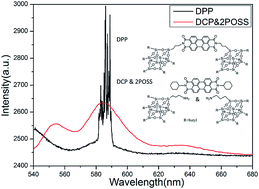Coherent random lasing from nano-scale aggregates of hybrid molecules by enhanced near zone scattering†
Abstract
Nano-scale aggregates of hybrid molecules, such as N,N′-di-[3-(isobutyl polyhedral oligomeric silsesquioxanes)propyl] perylene diimide (DPP) which is composed of perylene diimide (PDI) as gain group and polyhedral oligomeric silsesquioxanes (POSS) as scattering group at a mole ratio of 1 : 2, are formed in carbon disulfide (CS2) solution within a concentration range from 3 × 10−5 M to 10−3 M. The aggregation of DPP in the solution was characterized using ultraviolet visible (UV-vis) and fluorescence spectroscopy. Under pumping of a 532 nm pulse laser, coherent random laser (RL) is produced from the aggregates in CS2 solution with a threshold of 17.4 μJ and a Q value of 2440 at a DPP concentration of 10−4 M. Enhanced near zone scattering by aggregation is thought to boost coherent RL. This research not only extends the RL system to the extremely weak scattering regime but also provides a new direction for research on nano-scale materials for lasers using molecular design.


 Please wait while we load your content...
Please wait while we load your content...